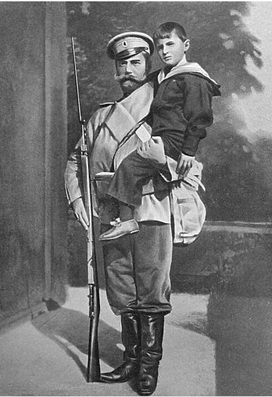|
|
Did You KnowUntil February 1918, the Russian 'Julian' calendar remained unreformed, so it was 13 days behind other countries. This is why we call 8-15 March: The 'February' Revolution, and the Bolshevik coup d’état of 6-8 November:The 'October' Revolution..
This can be confusing because different books use different dates.
|
|
On 1 November 1894, aged 26, Nicholas became Emperor of Russia, King of Poland, and Grand Duke of Finland - the 'Tsar':
Source AAccording to the mythology that was given official expression in the Fundamental laws, Russian Tsars derived from God the power they wielded, and … the rituals and ceremonies of the Church sought to foster an image of a pious, dutiful and fatherly figure whose heart was at one with his people. In this propagandistic endeavour, attention turned not to the military exploits of the many 'conqueror' tsars, but rather to the 'most-gentle' Tsar Alexis, whose mid-17th century life and reign came to exert a peculiar hold upon the religious imagination and devotions of Nicholas II. At a court ball celebrating the Romanov tercentenary in 1913, for example, he and Empress Alexandra dressed in costumes appropriate to the reign of Alexis, and onlookers agreed that this exercise in anachronism appeared to bring deep feelings of joy and peace to the face of the emperor John Hutchinson, Late Imperial Russia (1999). An analysis and sourcebook, written as an A-Level
students' and undergraduates' 'starter' text.
Source BIf a stranger now visited the Tsar's little palace at Tsarskoe Selo, they would find it kept exactly as it was... The guide might explain to them that the last Tsar was a healthy out-of-door man, delighting in his beautiful swimming bath, that the Empress's drawing-room was also almost a nursery, the centre of the family life, that the two sovereigns were excellent parents, and that their children were devoted to them. What theyhe would inevitably feel would be, that all this happened far back in the Middle Ages. Bernard Pares, The Fall of the Russian Monarchy (1939). Pares was British Ambassadir in Russia in 1917. He had travelled extensively in Russia, and based his books on huge research.
|
Source C
When in 1909 a new uniform was due to be introduced to the Russian Army, the Tsar
marched 20km/ 8 hours in the uniform of an ordinary soldier, with rifle, full
kit and food for a day, to make sure it was comfortable.
Consider:Study Sources A-C. How do they portray Nicholas, and what he believed about himself? What two words does Hutchinson (Source A) use to describe this portrayal?
|
|
|
|
|
Spotted an error on this page? Broken link? Anything missing? Let me know. |
|
